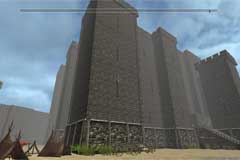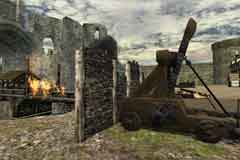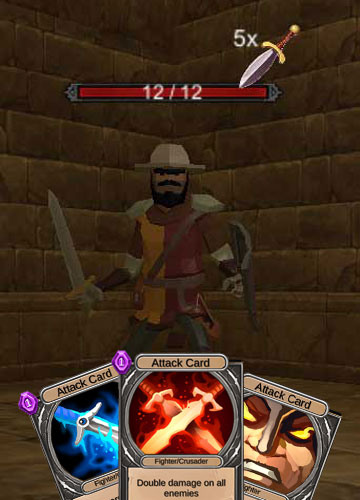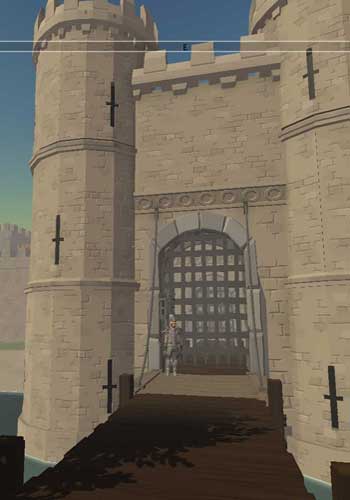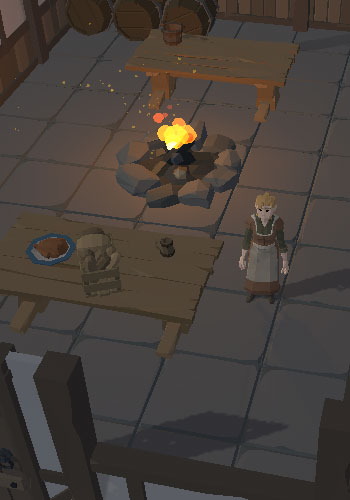A castle was a well fortified building and when the gates were shut and the drawbridge was raised it was a very difficult place for attackers to get into. Medieval soldiers employed many tactics in their attempts to breach a castle's defences. The term siege is defined as the action employed by an army of surrounding a fortified location cutting its inhabitants off from escape or resupply while being attacked.

The attackers, or besiegers, had several types of siege engines that they used in their attempts to break into a castle, but even with the strongest engine a siege could last months. The attackers sometimes had to wait until the defenders in the castle had run out of supplies and surrendered the castle.
Siege Preparations
The besieging army had to protect itself from attacks from the castle's inhabitants and possibly their supporters outside the castle. It was common for the besiegers to construct two lines of defence around the castle. The first line of defences was built between the besiegers and the castle and was known as the circumvallation. The second line, known as the contravallation, was built around the besiegers so that they were surrounded by defensive walls. Both lines of defence consisted of earth banks and wooden palisades. There was a danger that the besiegers themselves would be besieged within their fortifications. Within these lines the besiegers set up their camps and built their siege engines.
Types of Siege Engine
The Trebuchet
This was the largest of all siege engines. It was designed to throw large rocks and missiles at castle walls to destroy them. Trebuchets came in many shapes and sizes, some having wheels so they could be moved around the siege landscape. Trebuchets were built as kits that could be assembled and disassembled and transported in sections to where they were needed. All the pieces slotted together and were fixed with wooden or metal pegs.
A Siege Tower
The siege towers or belfry was designed to allow attackers to get up over the top of castle walls. The tower had wheels so that it could be pushed up to the castle walls and a drawbridge at the top would be lowered when the tower was in place. To protect the tower from fire it would have been covered with animal hides.
The Battering Ram
The battering ram was used to destroy the gates or walls of a castle. It would be hidden under a wooden roof to protect the men who controlled it and mounted on wheels so that it could be moved into position.
The Cat
The cat or sow was a wooden shed mounted on wheels. It had a wooden roof angled so that missiles would bounce off and was covered in animal hides to protect it from fire. The cat would be moved up to the castle with men inside safe from attack from the castles walls. This siege machine was used when a section of the moat needed filling in so that a siege tower could be moved into position. It could also be moved right up to the castle so that the men inside could hack away at the walls in an attempt to weaken them.
The Mangonel
The mangonel was another siege engine that propelled boulders. It had a throwing arm like the trebuchet but worked on a different principal. The arm was slotted through rope so that when the arm was lowered the rope twisted and provided enough energy to make the arm spring back when released.
Trebuchet Game (Beta Version)
Take control of a medieval trebuchet to destroy the enemy castle and capture their flag.
Instructions:
- Click the trebuchet or press the space bar to launch the projectile.
- To get the best result wait for the basket to swing back to the left.
- The trebuchet will reload automatically after each shot.
- The game have been tested on desktop IE10, IE11, Chrome and Firefox. It may not work on mobile or other browsers.
- This game in under development and will be improved at a later date.
Undermining and defending against it
It was possible to destroy castle walls from above the ground using trebuchets and mangonels but it was also possible to bring castle walls crashing down from beneath the ground. The besiegers employed skilled miners who could construct tunnels starting from their camps and ending beneath the castle walls. Under a section of wall the miners would remove the foundation stones replacing them with wooden props. Once enough of the wall had been removed a fire was lit beneath the wooden props and the miners left the mine. When the props burnt through there was nothing holding the castle wall up and it would collapse. The corners of square castles were the weakest part of the construction and this is where the miners would aim to tunnel beneath.
Tactics to counteract undermining
- The castle's defenders used a tactic called countermining. This involved digging a tunnel from within the castle to intercept the attackers mine and kill the enemy miners.
- Castle designers added buttresses and extra projections extending from the walls of the castle. These gave the walls a larger foot print and made them more difficult to undermine.
- Removing sharp angles from castle designs helped reduce the weak points. Polygonal and round castles were the result of this change in design.
Any defendable site needs a good water supply and many had wells. An attacker would attempt to disrupt the water supply to shorten the length of the siege.
Possibly the most effective way of capturing a castle was to prevent supplies entering it and starving the castle's inhabitants into submission. This could be a slow process as a well stocked castle with a well could hold out for many months.
With limited access to water cleanliness is always a problem and a cause of disease. This was not just a problem for the people being besieged, it was also a problem for the attackers as well. If the The siege went on for too long disease coudl spread through the besigers' camp.

| Year/Location | Details |
| 885 Paris |
A fleet of Viking longships sailed up the River Seine heading for eastern France and new lands and cities to plunder, When they reached Paris the Vikings offered to spare the city if they were allowed free passage up the river. The river was blocked by bridges that crossed and prevented even the Viking ships passage. Their request was denied and so the Vikings laid siege to the city. The siege was broken when an army led by Emperor Charles the Fat arrived. Charles agreed to pay the Vikings off and allowed them passage past Paris to Burgundy which they plundered. |
| 1016 London |
Edmund Ironside had gone to Wessex to accept the support of the people there as the new king of England but Canute had reached London and was besieging its inhabitants. The Londoners held out against Canute's attempts to defeat them while Edmund travelled back to help. Edmund's army grew as he advanced towards Canute. The English won a couple of battles forcing the Danes to retreat and regroup but the Danes won the important battle at Ashingdon. |
| 1054 Domfront |
The siege of Domfront, a stong stone castle in Angevin, ended when the garrison surrendered. The garrison feared the same punishment dealt out to defenders of Alençon by Duke William who showed them no mercy. |
| 1068 Exeter |
Harold's mother Gytha and her forces still had not submitted to William the Conqueror's rule. They refused to pay the taxes that William demanded and held out at Exeter until their defences were broken. |
| 1069 York |
An army sent by Sweyn of Denmark landed in the north and captured York. Local rebels joined the Danes and attacked the two castles within the city. |
| 1093 Alnwick |
Malcolm III, the king of Scotland, and his son Edward were both killed at the battle of Alnwick in Northumberland. Malcolm had invaded England after William II had made moves to take more control over Cumbria and had fortified Carlisle. |
| 1141 Winchester |
Matilda's forces were besieging a royalist held castle at Wolvesey near Winchester and were attacked and defeated by a royalist relief army. |
| 1147 Lisbon |
Lisbon was being held by the Moors when Alphonso I, the first king of Portugal laid siege to the city. The king was assisted by crusaders from many different countries including Portugal, Germany and Flemish. Several attempts were made to move wooden belfries into position against the city walls but they were attacked and set alight by the Moors. The attackers had more success with mines constructed underneath the walls. Fires were lit under the walls and a breach occurred. Although the attackers were beaten back, the Moors finally surrendered in October when another belfry was constructed. |
| 1142 Oxford |
Oxford was besieged by King Stephen trapping Matilda inside the city. But just before Christmas Matilda managed to escape across the snow and ice of the frozen Thames dressed in white so that she would not be seen. |
| 1153 Ascalon |
King Baldwin III laid siege to the port city of Ascalon. The city was surrounded and the only means of communications was by sea. Resupply was difficult by sea but the city had several wells to provide fresh water so the inhabitants were not easily pursuaded to surrender. The attackers built a tall tower near the walls so that they could fire over the defences into the streets. When the defenders set fire to the tower it collapsed taking part of the city walls with it allowing the Templars to enter the breach. But the knights were outnumbered and killed and the breach was repaired. The siege finally took its toll on the inhabitants and they agreed to surrender in return for safe passage. |
| 1158 Milan |
Frederick Barbarossa laid siege to the important city in northern Italy in an attempt to bring the area under his control. The city fell within a month. |
| 1161 Milan |
Barbarosa again laid siege to Milan. It took a year to before the city surrendered, and this time it was razed to the ground. |
| 1187 Jerusalem |
Jerusalem fell to the Muslims and the al-Asqu mosque was returned to Islam. The Muslims allowed four Christian Priests to hold services in the Church of the Holy Sepulchre. |
| 1191 Acre |
Under King Richard's command, the city of Acre is taken back by the Crusaders. |
| 1192 Jaffa |
When King Richard left Jaffa Saladin took his army out of Jerusalem and attacked the city. After three days of assault the walls of Jaffa fell and the Moslems entered. |
| 1199 Chalus |
King Richard besieged the castle at Chalus where some treasure had been unearthed. Richard believed it was his and tried to take the castle. |
| 1216 Odiham |
King John's last visit to Odiham Castle was on April 14th, staying there for five days. In the middle of June Louis captured Winchester and marched to Odiham where a siege began. The small castle held out for several weeks and defied the French siege engines. Inside the castle were less than twenty men, a hand full of knights and ten sergeants. Finally on the 9th of July, they surrendered being assured they would retain their freedom, arms and horses. |
| 1216 Rochester Castle |
Invited by the barons opposed to king John, Prince Louis of France landed in England to claim the English Throne. Louis captured Rochester Castle after a short siege. |
| 1217 Mountsorrel Castle |
Royalists besieged the French controlled Mountsorrel Castle in Lincolnshire. When Louis sent reinforcements to assist those in the castle the royalists moved away to Nottingham. |
| 1224 Bedford Castle |
The garrison at Bedford Castle, belonging to the rebel Falkes de Breute, refused to surrender to the Crown. Falkes had been repeated summonsed to account for his refusal to comply with agreement and when he refused to appear before the King the castle was surrounded. The castle fell when the keep was undermined. The garrison, who had surrendered the castle, were all hung on the order of the Justiciar. Falkes was allowed to leave the country but he lost all his possessions in doing so. Bedford Castle was badly damaged as a result. |
| 1296 Berwick |
King Edward ordered his army to attack the badly fortified town of Berwick. Many Scots were killed in the two days of the attack and possibly somewhere between 7000 and 17000 men, women and children were slaughtered. |
| 1304 Stirling |
Edward began a siege of Stirling Castle. |
| 1313 Stirling Castle |
Stirling castle was still under the control of English forces but was under siege from the Scots led by Edward Bruce. |
| 1333 Berwick |
After the defeat of their relief force at Halidon Hill the day before, the Scots holding out in Berwick had no option but surrender to the English and Edward III. |
| 1415 Harfleur |
King Henry V's army landed on the north bank of the Seine estuary near to the town of Harfleur (now part of Le Havre). Henry organised the siege of the town and waited for it to fall. The town held out for five weeks in which time the English soldiers were starting to suffer from disease caught from their camps in the marshes. The people in the town were not doing much better and when it was clear that the town was not going to be rescued, the citizens surrendered. Henry treated the towns people with respect and let them leave. |
| 1417 Caen |
Once in France, King Henry V appointed his brother the Duke of Clarence as Marshall of his army and together they advanced and laid siege to the city of Caen. Henry's attempt to storm and breach the walls failed, but his brother's attack on the other side of the walled city succeeded and the city fell to the English. It took several more days for the fortified castle within the city to be captured. |
| 1418 Rouen |
King Henry V of England was not troubled by any Burgundian attempts to stop his progress and by the end of July had begun the siege of the important city of Rouen. By December so many people in the besiged city of Rouen were starving that as many as 12,000 people were forced to leave. But King Henry refused to let them pass through the his lines and they remained stuck between the English and the walls of the city without food in the freezing weather. Many of them died. The city surrendered in the January of 1419. |
| 1472 Beavuais |
After King Louis of France failed to turn over several towns to the Burgundians Charles the Bold attacked and took back some of them by force. But when he tried to capture Beauvais the defences were too strong. A siege was begun and some parts of the outer defences were destroyed but finally Charles withdrew his army and moved on. |
| 1529 Vienna |
Suleiman, the sultan of the Ottomans, attempted to capture Vienna and laid siege to the city. But the defences were too great and after two weeks Suleiman abandoned the siege due to heavy loses, illness and the weather. |
Page Navigation

More castle pages
Pages in this section
Types of castles

Medieval Castles
Types of castles
- Early Fortifications
- Castles of William the Conqueror
- Earthwork castles
- Motte and bailey castles
- Square keeps
- Shell-Keeps
- Polygonal Keeps
- Concentric Castles
Other details











